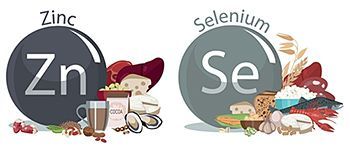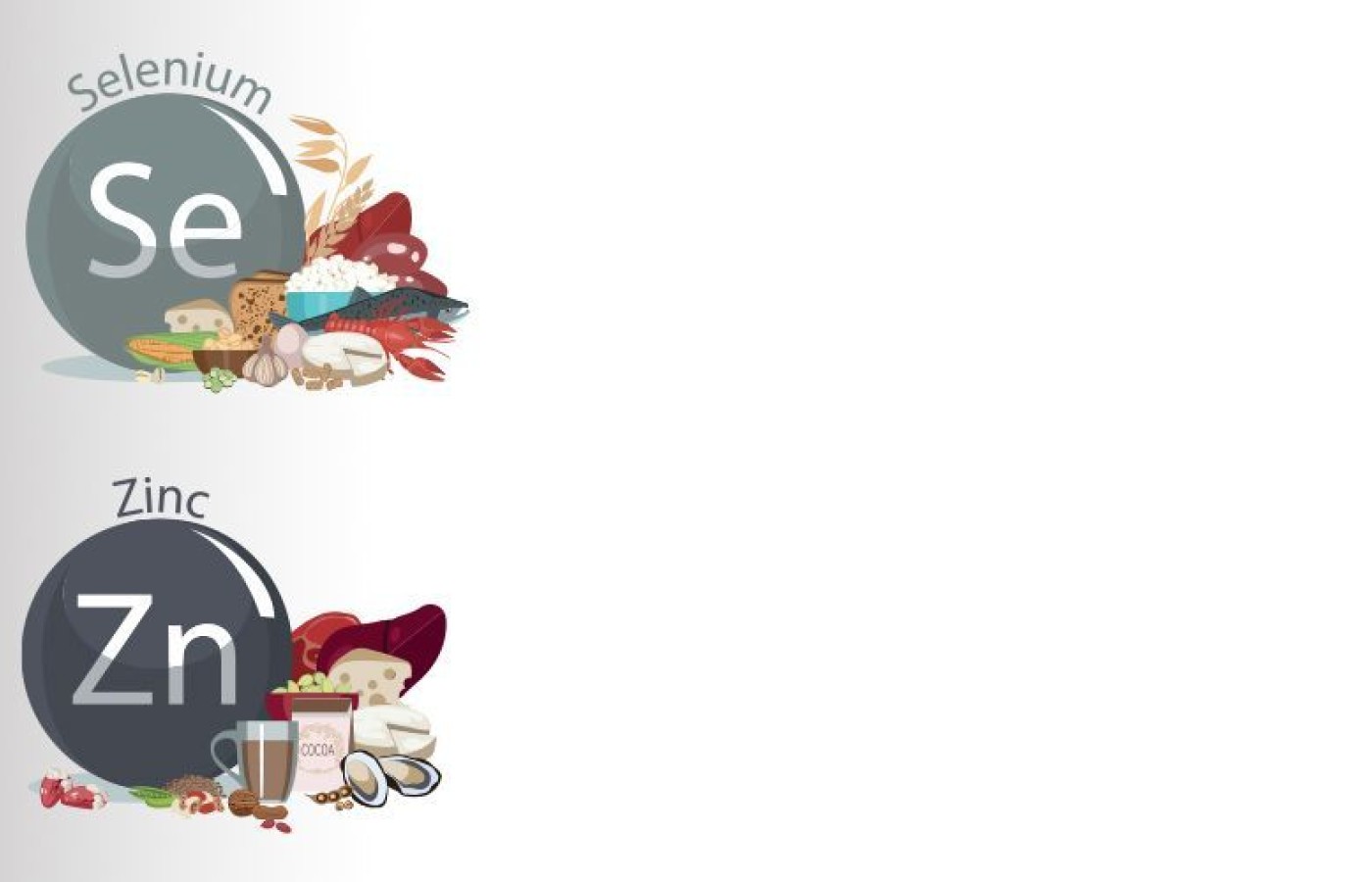Whether you accept it, avoid it or live somewhere in between, insurance coverage has become a defining issue for our profession. Patients increasingly expect to use their benefits, practitioners want to be compensated fairly for their time and expertise, and the system itself remains – at best – fragmented. The encouraging news is that coverage has expanded in meaningful ways. The challenging news is that reimbursement, across the board, remains inadequate.
Zinc & Selenium: Big Benefits – But Are Your Patients Getting Enough?
Zinc and selenium are essential, have great name recognition, and are absolutely crucial for a strong immune response and defense against tumors. But it's also highly likely your patients don't get enough of them from diet alone – and that could put them at significant risk.
Zinc Fights Viruses and Bacteria
With defense against viruses and bacteria being a top-of-mind and year-round concern for your patients, they should know that it is an absolute must for a strong immune system.
Zinc is a requirement for T-lymphocyte (white blood cell) activity that fights bacterial and viral threats. It also acts as a messenger, relaying front-line updates about these threats between the innate and adaptive immune systems so they can kick into gear to stop a familiar illness or adapt to stop novel viruses that someone has not previously encountered.1
Zinc stops viruses from replicating because it halts the proteins in those viruses from using the host's own cells to create more copies of itself. Because of this, zinc can have a noticeable effect on reducing cold and flu symptoms.1-2 In fact, researchers who pooled the results of three clinical studies found zinc reduced the duration of cold symptoms by 42 percent compared to a placebo.

But timing is critical when it comes to zinc. These same researchers noted taking zinc at the first sign of symptoms is what accounts for results within the first 24 hours.3-4
The Synergy of These Minerals
Research indicates that zinc works synergistically with selenium in the immune system. A lack of either mineral can lead to increased oxidative stress, more inflammation and out-of-balance CD4:CD8 lymphocyte ratios. Without these minerals, individuals may be much more prone to dealing with respiratory issues.5
For example, selenium and zinc levels tend to be lower in cases of asthma. Clinical research has shown that these deficiencies ramp up C-reactive protein levels, create an imbalance of lymphocytes, lower levels of antioxidant enzyme activity (like glutathione), and simply reduce overall respiratory function.6
The Power of Selenium
Selenium restores antioxidant capacity in the lungs and moderates inflammation in the lungs through interleukin-1-beta (IL-1B) and interleukin-6 (IL-6) pathways, providing a measured immune response. This is a key point for anyone who deals with allergies, asthma or other conditions in which an immune response that is too intense could be a liability, rather than a comfort.5,7
Selenium can also be used as an add-on therapy for treating viral and bacterial infections, because it fights influenza-A (a common flu) and appears to stop (or at least slow down) more contagious viruses.6
As with zinc, a selenium deficiency puts immune resilience at risk. Research from the University of Chapel Hill in North Carolina shows selenium deficiencies can increase susceptibility to viral variants. So, it's possible that even though an individual recovers from a viral infection, if a variant comes along fast enough, they may not have the reserved strength to fight it effectively.8-10
Bear in mind that over 2 billion people worldwide are deficient in zinc and selenium.11-13 Anyone lacking in these nutrients is much more likely to not only be infected by a virus, but also to actually be affected by new and stronger strains of the virus, so there's a great need for a daily, consistent intake of effective levels of these critical minerals.
Tumor Reduction and Cancer Prevention
Some of the same anti-inflammatory and antioxidant attributes that make zinc and selenium so powerful for immune defense also make them effective for tumor reduction and cancer prevention.
Regarding supplementation, it is important that your patients know that zinc is not readily available for the body to pull from reserves when it is needed, and what zinc they may have on board could be depleted quickly due to stress, injuries, infections, or simply normal immune-protective activity.14-15 This may be why deficiencies of zinc are reported in cases of lung and breast cancers: there simply isn't enough zinc on board to stop these conditions from starting in the first place.
Zinc is critical for proper cell division and differentiation, DNA and RNA repair, and the overall strength and stability of cells. Zinc reduces the risk of tumor development because it balances the ratio of T-helper cells – the same cells that protect someone from viruses; and stimulates the release of interferon gamma (INF-y), a cytokine that kills cancer cells and stops the spread of tumors.16
Likewise, selenium deficiencies may be a risk factor for cancer. In addition to strengthening immune defenses, selenoproteins from selenium reduce the risk of tumors by interrupting flawed DNA replication that would otherwise be the starting signal for cancer growth.5,17-19
Findings originally reported in the Journal of the American Medical Association show that 200 mcg of supplemental selenium daily significantly reduces the incidence of lung and prostate cancers, especially in individuals who are deficient in the mineral.20
Supplementation Is Critical
If your patients aren't getting enough zinc and selenium through diet alone, it may be time to add this mineral combination to their protocol. Supplemental zinc chelated to the amino acid glycine is efficiently and effectively absorbed, so it can deliver consistent levels of the nutrient. Supplemental selenium in the selenium yeast form (Saccharomyces cerevisiae) is readily bioavailable and has been shown to reduce the risk of cancers, making it a true essential.
So, while each mineral no doubt has good name recognition, ensuring patients have what they need for optimal health may require your additional expertise to let them know what a critical difference these nutrients can make.
References
- Keflie TS, Biesalski HK. Micronutrients and bioactive substances: their potential roles in combating COVID-19. Nutrition, 2021 Apr;84:111103.
- Kido H, Okumura Y, Yamada H, et al. Proteases essential for human influenza virus entry into cells and their inhibitors as potential therapeutic agents. Curr Pharm Des, 2007;13(4):405-14.
- Hemilä H. Zinc lozenges may shorten the duration of colds: a systematic review. Open Respir Med J, 2011;5:51-8.
- Godfrey JC, Conant Sloane B, Smith DS, et al. Zinc gluconate and the common cold: a controlled clinical study. J Int Med Res, 1992 Jun;20(3):234-46.
- Avery JC, Hoffmann PR. Selenium, selenoproteins, and immunity. Nutrients, 2018;10(9):1203.
- Steinbrenner H, Al-Quraishy S, Dkhil MA, et al. Dietary selenium in adjuvant therapy of viral and bacterial infections. Adv Nutr, 2015;6:73-82.
- Mahmoodpoor A, Hamishehkar H, Shadvar K, et al. The effect of intravenous selenium on oxidative stress in critically ill patients with acute respiratory distress syndrome. Immunol Invest, 2019 Feb;48(2):147-159.
- Beck MA, Nelson HK, Shi Q, et al. Selenium deficiency increases the pathology of an influenza virus infection. FASEB J, 2001 Jun;15(8):1481-3.
- Beck MA, Levander OA, Handy J. Selenium deficiency and viral infection. J Nutr, 2003 May;133(5 Suppl 1):1463S-7S.
- Schomburg L. Selenium deficiency in COVID-19 - a possible long-lasting toxic relationship. Nutrients, 2022 Jan 11;14(2):283.
- Johnston JL, Fanzo JC, Cogill B. Understanding sustainable diets: a descriptive analysis of the determinants and processes that influence diets and their impact on health, food security, and environmental sustainability. Adv Nutr, 2014;5(4):418-429.
- Prasad AS. Discovery of human zinc deficiency: 50 years later. J Trace Elem Med Biol, 2012;26(2-3):66-69.
- Jones GD, Droz B, Greve P, et al. Selenium deficiency risk predicted to increase under future climate change. Proc Natl Acad Sci (USA), 2017 Mar 14;114(11):2848-2853.
- Skrajnowska D, Bobrowska-Korczak B. Role of zinc in immune system and anti-cancer defense mechanisms. Nutrients, 2019 Sep 22;11(10):2273.
- King JC. Zinc: an essential but elusive nutrient. Am J Clin Nutr, 2011;94(2):679S-84S.
- Castro F, Cardoso AP, Gonçalves RM, et al. Interferon-gamma at the crossroads of tumor immune surveillance or evasion. Front Immunol, 2018 May 4;9:847.
- Jab�o�ska E, Reszka E. Selenium and epigenetics in cancer: focus on DNA methylation. Adv Cancer Res, 2017;136:193-234.
- Barrera LN, Cassidy A, Johnson IT, et al. Epigenetic and antioxidant effects of dietary isothiocyanates and selenium: potential implications for cancer chemoprevention. Proc Nutr Soc, 2012;71(2):237-245.
- Radomska D, Czarnomysy R, Radomski D, et al. Selenium as a bioactive micronutrient in the human diet and its cancer chemopreventive activity. Nutrients, 2021;13(5):1649.
- Clark LC, Combs GF Jr, Turnbull BW, et al. Effects of selenium supplementation for cancer prevention in patients with carcinoma of the skin. A randomized controlled trial. Nutritional Prevention of Cancer Study Group. JAMA,1996 Dec 25;276(24):1957-63. Erratum in: JAMA, 1997 May 21;277(19):1520.



